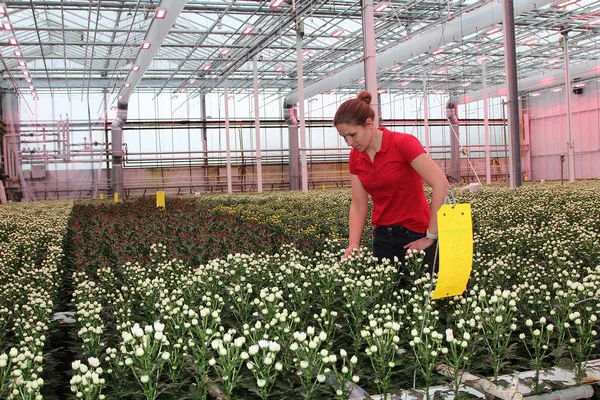In 2018 and 2019, Delphy IC in Bleiswijk, the Netherlands, had two research departments of 1,000 m2 equipped with AVS-C ventilation units. It was the start of multi-year research into fossil fuel-free cultivation. “This system offers a firm grip on glasshouse climate control,” says Lisanne Helmus, Research Manager. “Thanks to the cooling and heating blocks, we’re able to easily adjust the inlet temperature and completely disconnect temperature and humidity control. In combination with thermal energy storage and a heat pump, we use hardly any gas.”
The multi-year, energy-efficient cultivation trials at Delphy Improvement Centre will certainly receive great interest from the sector. That was already the case before the price of natural gas and electricity went through the roof in 2022. Now the necessity for energy efficient cultivation is greater than ever.

Helmus: “We do it by consistently applying the principles of energy-efficient cultivation. So we rely heavily on screens, use full LED lighting installations and have facilities to harvest and store excess heat, so that we can meet the heat demand later."
Active dehumidification
Efficient cultivation under full LED and closed screens means that the moisture that evaporates during the heating season cannot be removed via screen gaps and air vents. After all, this would also cause a lot of energy loss. The AVS-C units have both a heating block and an extra cooling block, which extracts moisture from the greenhouse air. During condensation of the moisture, (latent) heat is released, which is removed and stored for later use, when there is demand for it.
Short and long-term storage
For that purpose, Delphy IC has a heat pump and cold & heat storage facilities for both short and longer periods of time.
Helmus: “In the trials we are mainly focusing on harvesting heat and using it again in the short term, because this requires lower investments. The way we use it in the trials is most relevant. On balance, we have to use very little gas to meet the heat demand. Last year, this was only about 5 m3/m2 for the tomato cultivation with artificial lighting. Thanks to AVS-C, we were able to make up the rest from the short and long-term storage systems. We also used electricity, of course, which in the future will mainly be generated in a sustainable way.”
Versatile
When asked about how it differs from other systems for active dehumidification, the research manager says: “With the AVS-C, you have multiple options and you are less dependent on the conditions outside. You can dehumidify using outside air that is drawn in, as well as ventilate and dehumidify internally via the cooling block. In addition, you can use the harvested heat immediately, or store it for later use. Not all systems can do that. We are grateful to be able to take advantage of this versatility to have maximum control of the climate with minimum use of fossil fuels.”
New sweet pepper trial
At the research institute they like the active ventilation system so much that a third department was equipped with it in 2022. “The trials for fossil fuel-free tomato and chrysanthemum crops without artificial lighting are ongoing,” Helmus says. “This year we also started a multi-year sweet pepper trial. AVS-C enables us to take extra steps in energy saving.”
Since there is no artificial lighting, there is less moisture to manage during the first stage. This also means that less latent heat can be harvested and there will be less excess heat. Another new aspect is that the distribution hoses for the treated air are not hung underneath the cultivation gutters, but above the crop, as in the chrysanthemum greenhouse.
Temperature gradient
“That’s not common in fruit vegetable crops, but we made a conscious decision to do it this way,” says Helmus. “When you bring relatively cool air to the bottom of the greenhouse during active dehumidification, it will linger there longer and mix less easily with the rest of the greenhouse air. This is detrimental to the temperature gradient. We think it would be useful to gain experience with the installed distribution hoses. They’re transparent, which limits light loss. The results will have to show whether this actually leads to efficiency gains and whether it can be applied on a larger scale.”
For more information:
Van Dijk heating
+31(0)30 656 38 44
info@vandijkheating.com
www.vandijkheating.com
